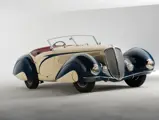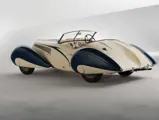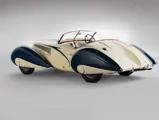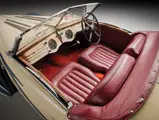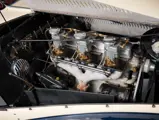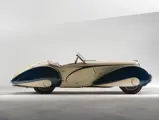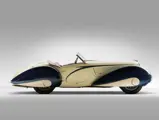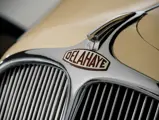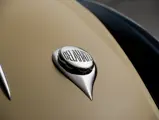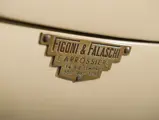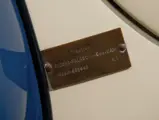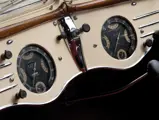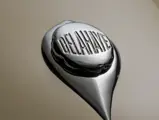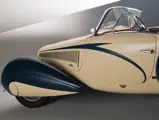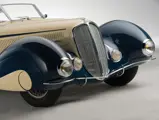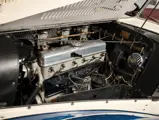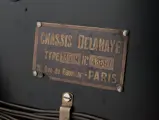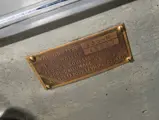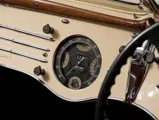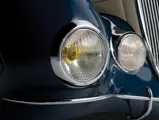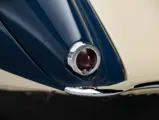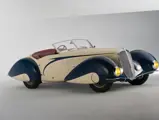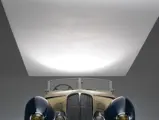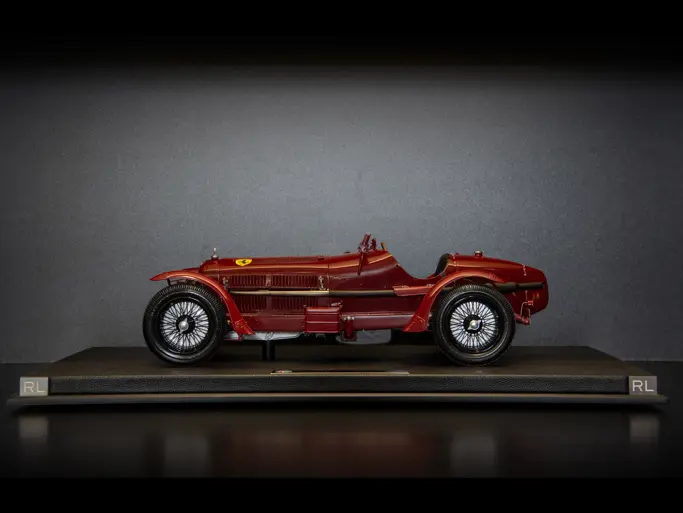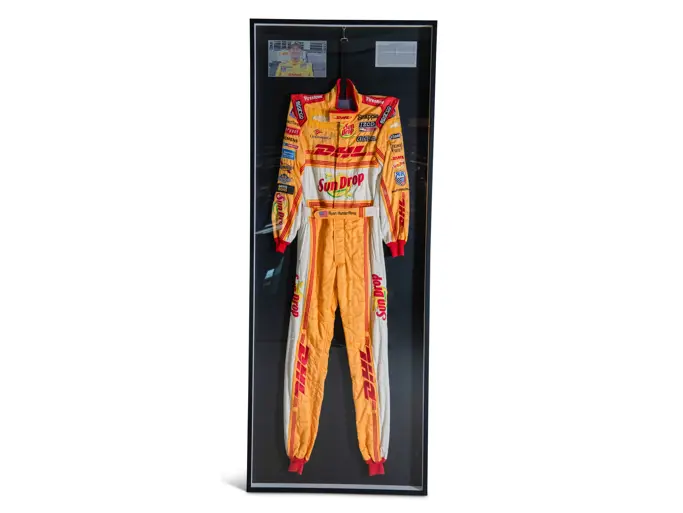Amelia Island 2014
1937 Delahaye 135 Competition Court Torpedo Roadster by Figoni et Falaschi
Offered from the Pray Collection
{{lr.item.text}}
$6,600,000 USD | Sold
 | Amelia Island, Florida
| Amelia Island, Florida
{{internetCurrentBid}}
{{internetTimeLeft}}

- Offered from the Pray Collection
- Single ownership for half a century
- One of two surviving short-chassis examples; the ultimate Type 135
- The only surviving example with its Geo Ham body tag
130 cv, 3,557 cc inline overhead-valve six-cylinder engine, four-speed manual gearbox, independent front suspension with transverse leaf spring, live rear axle with quarter-elliptic springs, and four-wheel assisted, mechanically actuated Bendix drum brakes. Wheelbase: 106.29 in. (2,700 mm)
It has often been said that a great automobile is one that can stand entirely on its own merits. Whether moving or standing still, it is not only beautiful, but it also has an almost magical aura that stops those who see it in their tracks. In the words of Thomas Wolfe, it is “freedom, sex, power, motion, color—everything.”
In the 1930s, a middle-aged illustrator and an 11-year-old boy both found everything in the same car. Neither would ever forget it.
PARIS, 1936
Chassis number 48667 was one of approximately thirty Competition Court chassis constructed. As described in Delahaye: Le Grande Livre, “The Type 135 Competition Court, which doesn’t show up on any price list, represents the special ‘Grand Sport’ version of the Type 135, destined for competition. Its assembly resulted from a cocktail of pieces that came from chassis Type 135 Series 3 and the Specials. Many mechanical options can make a model very close to the racing chassis, based on certain driving tests. Some Delahaye clients risked it, and not without success. Assembled based on client demand for at least two years, their evolution is not well-defined.” In essence, this model was the street version of the purely competition Type 135 S.
The relatively early number of 48667 indicates that the car’s chassis was likely laid down in 1936; thus, it is appropriate that it has the four-speed manual gearbox. It is also worth mentioning that the original chassis tag indicates Type 135-M, which is not to be unexpected, as Le Grande Livre further notes, “These chassis sometimes wear the build tag of the Type 135 M. We’re unsure of the reason, but likely for homologation purposes.”
The chassis was delivered to France’s most prominent coachbuilders, Figoni et Falaschi, of Paris. According to the Figoni archives, the car was commissioned not by a private individual but rather by Delahaye itself, indicating its planned use as a show car.
The design for the Torpedo Roadster that clothes the chassis is based on the famed 1936 Paris Auto Show car. Its form has traditionally been recognized as a collaboration between Figoni and the illustrator Georges Hamel, or “Geo Ham,” who remains widely recognized for his depictions of airplanes and automobiles in racing posters of the period. Although credit has long been given to Figoni and Ham, recent debate indicates that its roots lay in a design penned and published in 1934 by designer Alexis de Sakhnoffsky. In any case, the Paris Auto Show car of 1936, constructed by Figoni et Falaschi with the input of Geo Ham, was the first of what would become a series of 13 streamlined bodies.
The series was comprised of both open and closed cars that were based on long and short chassis, with each having its own unique characteristics. In producing these subsequent bodies, Figoni et Falaschi initially refused to acknowledge Ham’s contribution to the design. The illustrator threatened a lawsuit, and an agreement was soon struck, by which Ham was allowed to register bodies 6, 7, and 8 as his creations, under the Union of Artistic Property. Each of these cars bore a brass tag, affixed just aft of the doors, acknowledging this agreement.
One of these three cars was the Delahaye factory’s chassis number 48667, which still retains its original tag, “Creation Figoni-Falaschi-Geo Ham modele depose No. 7,” to this day. This car is one of only two short-chassis Torpedo Roadsters that survive, and it is the only one to retain the original Geo Ham tag. In addition to this very special feature, it was given other touches indicative of its original career as a showstopper, including a dummy fuel filler cap on the driver’s side and the absence of courtesy lights mounted on the rear fenders. This automobile, finished in Blue Monaco and Straw Yellow, was built purely for beauty.
Delivery of the Torpedo Roadster was made to Delahaye on August 8, 1937. Over two months later, on October 21, it was shown at the Gardenia Concours d’Elegance at Saint-Cloud, where it was presented by Ovidio Falaschi’s lovely stepdaughter, Emilienne d’Avray. Photos of the car at the concours were published for the first time in marque expert Jean-Paul Tissot’s Figoni & Delahaye.
It is unknown whether the car was intentionally retained by Delahaye for its own show and demonstration purposes or it simply remained as unsold inventory in tough economic times. The consensus among historians, however, is that, around 1939, it was repowered with an MS-specification engine. This theory is supported by the fact that the car retains its original engine tag, numbered 48667, which is an item that would certainly not have been retained had the engine been changed post-war.
In 1939, with this new powerplant installed, the Delahaye boarded a ship, and it set off across the Atlantic Ocean for adventures in the New World.
NEW YORK, BEFORE THE WAR
In Manhattan, the storm clouds of future war were darkening overhead, but Bob Grier scarcely noticed. Grier, a photographer and passionate motorist, filled his spare time with a fabulous rotating collection of the greatest automobiles, which were shared among a circle of friends that included Henry Austin Clark Jr., Alec Ullman, and the racing great Rene Dreyfus. One of these cars was a certain Delage D8-120 Cabriolet Deltasport, which everyone in New York knew, as they had seen it as the star of the French Pavilion at the 1939 World’s Fair. When the fair closed, Grier took delivery of the Delage, assisted by Werner Maeder, of the famed Zumbach’s Garage, and some obliging firemen, as is recounted by Ralph Stein in The Great Cars.
In a recent conversation, Grier’s daughter, Lucy, recalled that the Delage was not her father’s only purchase around that time. The Delahaye has always been rumored to have been shown at the World’s Fair, but it is almost a certainty that Grier was the first private owner. She further recalls family outings in the Delahaye prior to the outbreak of the war and family vacations to Sebring.
Like most early enthusiasts, Grier was forced to mothball his stable through World War II’s hostilities. At war’s end, he joyfully resumed the Delahaye’s use as a pleasure vehicle, and together, Grier and Delahaye helped lead the charge into the post-war glory days of the European sports car.
Every teenage boy reading magazines in math class knew them by heart. When the first issue of Road & Track hit the stands in June 1947, it featured Bob Grier and his car, participating in the Motor Sport Club of New York’s Mohansic Lake Hill Climb on March 30. A September 1949 issue of MoToR depicts the car having been repainted, with its original color scheme reversed. The March 1950 issue of Motor Trend showed Grier and the Delahaye participating in another Motor Sports Club hill climb. Yet another photo depicts the car charging up a hill at the Greenwood Lake Hill Climb of the same year, with a cloud of dust trailing behind and Grier’s passenger keeping a close eye on the passing roadside brush.
New York City enthusiasts also knew Grier. He was a supporter of the various automobile shows that took place in New York City around this time, and in 1953, he and his friend Dreyfus co-authored an article for the program of Herb Shriner’s World Motor Sports Show, which was held at Madison Square Garden. The following year, the Delahaye appeared at that event, now held in January.
All the while, the Delahaye was kept in fine running order and had a stock of spare parts, which were acquired directly from the factory in 1948, as is documented by correspondence and receipts that are included in the car’s file.
Eventually, however, Bob Grier’s adventures came to an end. As Eisenhower was re-elected and the decade rolled steadily towards the 1960s, he sold many of his cars, including his prized Delahaye. According to the original New York Bill of Sale, it was acquired by Long Island’s Hempstead Auto Company, owned by Hugh J. Weidinger, on November 6, 1963, and it was retained by them for the next several months. Presumably, it was during this time that the color scheme was changed, to Red with Black accents. That was the dress in which a car dealer from Connecticut met a car that, for 25 years, had haunted his dreams.
GREENWICH, 1964
While Bob Grier was looking at buying a pair of French cars for his family at the 1939 World’s Fair, Malcolm Sheldon Pray Jr. was there, too, but he was only dreaming. Later in life, he recalled how struck he had been by the design of a Delahaye that was on exhibit there, so much so that he sketched its lines. He never threw out the sketch, and he never forgot the car.
On July 6, 1964, Malcolm arrived, as he often did, at the used car “dealer’s bazaar” under the Highbridge on Jerome Avenue in the Bronx; the same location from which he would purchase his Ferrari 250 GT five years later. On this day, two days after the Fourth of July, he found chassis number 48667 waiting for him, painted red with black accents. Memories within him stirred, and Malcolm, moved by emotion, just had to have it…so he did.
From that moment on, until Malcolm S. Pray Jr.’s passing half a century later, man and machine would never be far apart.
Between 1969 and 1970, the car was comprehensively refurbished by Don Leffert’s Vintage Auto Restorations, of Ridgefield, Connecticut, which included a refinish in Cream and Blue Monaco, the same colors that it wears today. Receipts for this work, and all subsequent work for the last 45 years, accompany the sale of the car. Yet, after all this work, the Delahaye was not a show car, nor did Malcolm join the crowd of enthusiasts that Bob Grier once enjoyed. For him, it was a beloved toy, to be exercised on weekends with the kids but seldom otherwise let out of the garage at his Round Hill Road estate.
As a result, chassis number 48667 remained virtually unknown outside a small circle of locals until 1994. That year, Malcolm decided to give his debutante a long-overdue debut at the Meadow Brook Concours d’Elegance, which was likely the Delahaye’s first show appearance since 1954! The automotive world was stunned, and a new life began for the 135, which became a celebrity in its own right.
In 1995, Malcolm and his new wife, Natalie, toured Europe in the car that she called his “French Mistress,” as its hold over her husband was that strong. They participated together in the Paris Concours d’Elegance and the Bordeaux-to-Paris Rallye.
Mrs. Pray recalls, “Driving through the French countryside on the rallye, Malcolm beamed with pride when bystanders along the road waved and shouted, ‘Belle voiture!’ His rapport with the car was palpable. He had the utmost confidence it would obey him, and it did. No trailer queen, the Delahaye went to Palm Beach in the winter, where Malcolm dashed along the ocean, top down. This timeless beauty was the jewel of Malcolm’s collection, which he showed and rallied at approximately 50 events. The Delahaye has many trophies, but none can measure the passion and joy Malcolm felt for his ‘French Mistress.’”
AMELIA ISLAND, 2014
Seventy-five years ago, a beautiful machine arrived in the United States from France, and it was acquired by an enthusiast ahead of his time. Sixty years ago, she blew up hill climbs and glittered amongst crowds. Fifty years ago, she met the man who loved her once, and who would never let her go again. Twenty years ago, she found the spotlight that had long neglected her. Today, she is offered to a new owner for whom, like Bob Grier and Malcolm Pray, the French Mistress is simply everything.
All interested parties are strongly encouraged to review the extensive history and documentation file that accompanies the sale of this car.
Titled as 1939.

